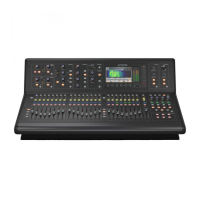Output:
1. The signal put out by a device. 2. The physical location of where
a device sends out a signal.
Output fast strip:
One of 16 channel strips in the output fast zone.
Provides detailed control of the currently selected outputs. See Output
fast zone.
Output fast zone:
Control area for fast access to primary main output
functions.
Overload:
A condition where the signal level is too high.
Overview:
The main view in the GUI channel strip, which contains the
control sections of the selected channel. This represents the associated
channel strip on the control surface.
Overview screen:
One of the GUI screens. This is the default screen of
the mix bay.
P
PAN:
Abbreviation for ‘panoramic’.
Panning:
The left/right positioning of a signal across a stereo image.
Parameter:
A setting whose value can be altered by the user.
Parametric EQ:
A type of EQ that allows all of the parameters of
equalisation to be changed, including centre frequency, boost/cut in gain
and bandwidth.
Patch:
A temporary connection (physical or virtual) made between two audio
devices or inside one.
Patch connector:
Any tab patching point, for example, an XLR connector,
bus, sidechain compressor etc. See Patching.
Patching:
Also known as ‘soft patching’. The process of routing a
channel/signal from a source to a destination(s).
PCB:
Abbreviation for ‘printed circuit board’.
PEQ:
Abbreviation for ‘parametric equaliser’. See Parametric EQ.
PFL:
Abbreviation for ‘pre-fade listen’. A function that allows the signal
to be monitored pre-fader, that is, before it reaches the fader.
Phantom power:
The power required for the operation of a condenser
microphone when it is not supplied by internal batteries or a separate
power supply. This is supplied by the M32 Control Centre itself.
Phase:
A measurement (in degrees) of the time difference between
two waveforms.
Pitch:
A continuous frequency over time. Musical interpretation of an
audio frequency.
Pitch shift:
Alteration of pitch or frequency, but without adjusting tempo.
Point scene:
Subdivision of a scene. See Scene.
Pointer:
1. On the GUI, the pointer is the arrow-shaped object on the
screen that moves when the user moves the trackball or external mouse. 2.
On a control knob, it is the marking that, when used in conjunction with the
ident around edge of control knob, helps to indicate the setting.
POP:
Abbreviation for ‘population’.
POP group:
A number of channels assigned to a group that has unfold
and area B controls. Provides an easy and quick method of manipulating
and controlling the numerous channels available on the M32 Control
Centre.
Post-:
The point for accessing audio just after it leaves a specific
channel component, for example, ‘post-fader’, where the audio is tapped
from just after it leaves the channel’s main level control.
Pre-:
The point for accessing audio just before it reaches a specific module, for
example, ‘pre-EQ’, where the audio is tapped from just before it gets to a
channel strip’s EQ.
Primary navigation zone:
Area in the master bay for mix and
master bay GUI screen navigation and control. Also has a
screen access section for fast access to GUI menu options.
Processing area:
A display in a GUI channel strip showing a
specific control section. Accessed from the channel’s overview
display. See Overview.
PSU:
Abbreviation for ‘power supply unit’.

